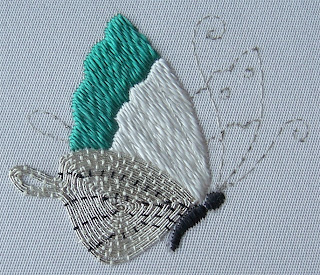I then added the green 2-1 twisted green silk to the wing tip. This is not the green that I originally chose. Jennifer Ashley Taylor who supplied the silk thought that the green I had selected was too yellow with my other colour choices and suggested this green in stead. Jennifer had given me a list of DMC colours that most closely matched her silks but the matches are not exact so, as I had not seen the actual silks, I was happy to accept her advice. I love green but this is not a shade that I would have been drawn to but I am so pleased that Jennifer suggested it, I think it is beautiful colour.

© Jennifer Ashley Taylor/Carol-Anne Conway
The second wing is behind the first and I have tried to emphasis this by stitching it in flat silk. Also I wanted to mimic the different textures of the front and back of a butterfly’s wing.

© Jennifer Ashley Taylor/Carol-Anne Conway

© Jennifer Ashley Taylor/Carol-Anne Conway
I had virtually no interruptions all day, the light was good, I was totally in the zone and the stitching just flowed. Usually, I will take out most of what I stitch at least once and do it again, but I barely took out a stitch. If only it could always be like that.
Happy Stitching.
PS. I am typing this in the kitchen, but I keep stopping to look out of the window. I have several bird feeders in the garden and they are teeming with birds. This morning I have seen the usual gang of great tits, blue tits, coal tits, green finches, chaffinches, siskins and sparrows; a pair of gold finches, a pair of doves, a robin, black birds, starlings, pigeons and a woodpecker who all are frequent visitors. Recently a fieldfare and a magpie have started dropping in and just now, my favourites, a gang of long-tail tits who only visit us now and then are vying for a place on the nuts. We also have a pair of squirrels who come regularly. I love watching them but they have a nasty habit of destroying the feeders, I scatter nuts on the ground to encourage them away from the feeders but they are greedy and want it all. I want to go and stitch but I can’t tear myself away from the birds!
















































